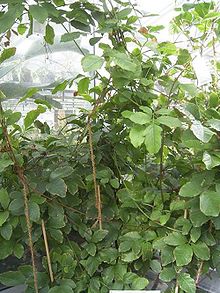| Guaraná | |
|---|---|

| |

| |
| Scientific classification | |
| Kingdom: | Plantae |
| Clade: | Tracheophytes |
| Clade: | Angiosperms |
| Clade: | Eudicots |
| Clade: | Rosids |
| Order: | Sapindales |
| Family: | Sapindaceae |
| Genus: | Paullinia |
| Species: | P. cupana
|
| Binomial name | |
| Paullinia cupana | |
Guaraná (/ɡwəˈrɑːnə/ from the Portuguese guaraná [ɡʷaɾɐˈna]; Paullinia cupana, syns. P. crysan, P. sorbilis) is a climbing plant in the family Sapindaceae, native to the Amazon basin and especially common in Brazil. Guaraná has large leaves and clusters of flowers, and is best known for the seeds from its fruits, which are about the size of a coffee bean.
As a dietary supplement or herb, guaraná seed is an effective stimulant:[1] it contains about twice the concentration of caffeine found in coffee beans (about 2–8% caffeine in guarana seeds,[2] compared to about 1–3% for coffee beans).[3] The additive has gained notoriety for being used in energy drinks. As with other plants producing caffeine, the high concentration of caffeine is a defensive toxin that repels insects from the berry and seeds.[4]
The color of the fruit ranges from brown to red and it contains black seeds that are partly covered by white arils.[5] The color contrast when the fruit is split open has been compared with the appearance of eyeballs,[5] and has become the basis of an origin myth among the Sateré-Mawé people.[6]
- ^ Johannes L (March 2, 2010). "Can a Caffeine-Packed Plant Give a Boost?". The Wall Street Journal. p. D3.
- ^ Schimpl FC, da Silva JF, Gonçalves JF, et al. (October 2013). "Guarana: Revisiting a highly caffeinated plant from the Amazon". Journal of Ethnopharmacology. 150 (1): 14–31. doi:10.1016/j.jep.2013.08.023. PMID 23981847. Archived from the original on 2021-03-23. Retrieved 2021-04-19.
- ^ Caporaso N, Whitworth MB, Grebby S, et al. (April 2018). "Non-destructive analysis of sucrose, caffeine and trigonelline on single green coffee beans by hyperspectral imaging". Food Research International (Ottawa, Ont.). 106: 193–203. doi:10.1016/j.foodres.2017.12.031. ISSN 0963-9969. PMC 5886291. PMID 29579918.
- ^ Ashihara H, Sano H, Crozier A (February 2008). "Caffeine and related purine alkaloids: biosynthesis, catabolism, function and genetic engineering". Phytochemistry. 69 (4): 841–56. Bibcode:2008PChem..69..841A. doi:10.1016/j.phytochem.2007.10.029. PMID 18068204.
- ^ a b Cite error: The named reference
Balstonwas invoked but never defined (see the help page). - ^ Prance G, Nesbitt M, eds. (2004). Cultural History of Plants. New York: Routledge. p. 179.